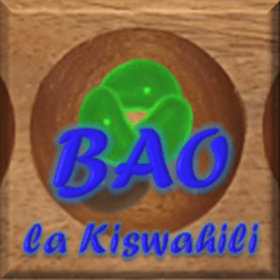Bao la Kiswahili
 Bao is an East African board game - actually, `Bao` is the Swahili word for `board game`.
Bao is an East African board game - actually, `Bao` is the Swahili word for `board game`.
It consists of a board with two rows of pits containing seeds. The objective is to move seeds around the board and thereby taking those of the opponent until he cannot move anymore.
This game is available in 3 versions: A simple one called `Hus Bao`, which is commonly played by kids. A more complex and strategic version called `Bao la Kujifunza`. And the full version called `Bao la Kiswahili`, which comes in 2 game phases and with a complex ruleset which is alos known as the `King of Mancala Games`.
It is highly recommended to thoroughly read the rules including the examples before playing the full version to understand why a move is possible or not and what the terms mean.
Also, for the first games when playing the more complex versions, it is recommended to not let the Kichwa selected automatically, in order to allow for better understanding of the different parts of the move and only later set it to not have repeatedly select the only possible option.
To help practicing the game or understand special rules, there is an editor option for training mode which allows for customizing the board freely.
Since it is not easy to fully understand all the rules and special cases, don't hesitate to contact the author and ask, he will happily assist with questions.
For those interested in the game development, have a look at https://github.com/geziefer/baolakiswahili.
Počet hráčov: 2
Trvanie hry: 10 mn
Zložitosť: 3 / 5
Hraj Bao la Kiswahili a 1194 ďalších hier online.
Nemusíš nič sťahovať - hráš priamo vo svojom webovom prehliadači.
S tvojimi priateľmi a tisíckami hráčov z celého sveta.
Zadarmo.

Hraj Bao la Kiswahili a 1194 ďalších hier online.
Nemusíš nič sťahovať - hráš priamo vo svojom webovom prehliadači.
S tvojimi priateľmi a tisíckami hráčov z celého sveta.
Zadarmo.

Zhrnutie pravidiel
Setup: Each player owns one half of the board consisting of 2 rows with 8 bowls each. Each bowl takes two stones. The first row is the one next to the opponent’s bowls.
Move selection: A player selects one of their bowls containing at least two stones for starting their move. Then they select one of the neighbor fields to determine the direction of the move. The move can be canceled by selecting the same field again.
Move execution: All stones from the selected bowls are taken and then starting with the selected neighbor field, they move around the player’s two rows in a circle, leaving one stone in each bowl. When the last stone is put into its bowl, the move either stops if it was empty before, or continues in the same way, by emptying the respective bowl and move further in the same direction, leaving stones in each bowl. If the latter happens with a bowl in the player’s first row and the opponent has stones in the directly adjacent bowl, they are taken as well for the move.
End of game: A player has lost if their first row is empty, or they have no bowls left with more than 1 stone.

